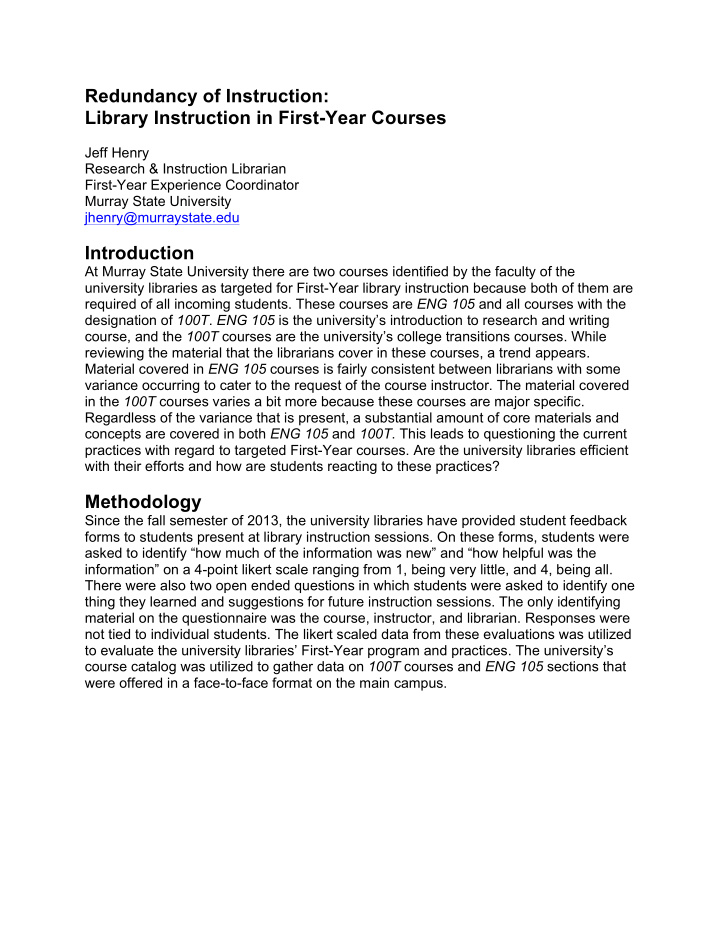



Redundancy of Instruction: Library Instruction in First-Year Courses Jeff Henry Research & Instruction Librarian First-Year Experience Coordinator Murray State University jhenry@murraystate.edu Introduction At Murray State University there are two courses identified by the faculty of the university libraries as targeted for First-Year library instruction because both of them are required of all incoming students. These courses are ENG 105 and all courses with the designation of 100T . ENG 105 is the university’s introduction to research and writing course, and the 100T courses are the university’s college transitions courses. While reviewing the material that the librarians cover in these courses, a trend appears. Material covered in ENG 105 courses is fairly consistent between librarians with some variance occurring to cater to the request of the course instructor. The material covered in the 100T courses varies a bit more because these courses are major specific. Regardless of the variance that is present, a substantial amount of core materials and concepts are covered in both ENG 105 and 100T . This leads to questioning the current practices with regard to targeted First-Year courses. Are the university libraries efficient with their efforts and how are students reacting to these practices? Methodology Since the fall semester of 2013, the university libraries have provided student feedback forms to students present at library instruction sessions. On these forms, students were asked to identify “how much of the information was new” and “how helpful was the information” on a 4-point likert scale ranging from 1, being very little, and 4, being all. There were also two open ended questions in which students were asked to identify one thing they learned and suggestions for future instruction sessions. The only identifying material on the questionnaire was the course, instructor, and librarian. Responses were not tied to individual students. The likert scaled data from these evaluations was utilized to evaluate the university libraries’ First-Year program and practices. The university’s course catalog was utilized to gather data on 100T courses and ENG 105 sections that were offered in a face-to-face format on the main campus.
Evaluation Fall 2013 In the fall semester of 2013, there were 48 100T courses offered and 32 sections of ENG 105 . Of these, the library reached 14 100T courses and 14 sections of ENG 105 . The library also offered several mass sessions for ENG 105 . 475 students in 100T courses and 428 students in ENG 105 provided feedback forms for the instruction sessions. Spring 2014 In the spring semester of 2014, there were 5 100T courses offered and 24 sections of ENG 105 . Of these, the library reached 4 100T courses and 12 sections of ENG 105 . 78 students in 100T courses and 165 students in ENG 105 provided feedback forms for the instruction sessions.
Fall 2014 In the fall semester of 2014, there were 53 100T courses offered and 35 sections of ENG 105 . Of these, the library reached 24 100T courses and 26 sections of ENG 105 . 872 students in 100T courses and 464 students in ENG 105 provided feedback forms for the instruction sessions. Spring 2015 In the spring semester of 2015, there were 7 100T courses offered and 25 sections of ENG 105 . Of these, the library reached 4 100T courses and 13 sections of ENG 105 . 75 students in 100T courses and 148 students in ENG 105 provided feedback forms for the instruction sessions. Conclusion For both First-Year courses in all semesters examined, responses given by students indicate somewhere between some and most of the information being new to them and a little more than most of the information being helpful to them. In some instances, there appears to be a slight correlation between the timing of the instruction session and the newness of the information, but, even in these instances, it is not consistently negative or positive, as one might expect. There does not appear to be anything that stands out consistently when comparing 100T and ENG 105 course feedback, which would indicate that the redundancy that occurs between the university libraries’ First-Year
library instruction sessions is negligible if not beneficial to enough students to warrant the continued practice. Discussion Student feedback indicates that the university libraries’ First-Year instruction session program is doing well, but it can always be improved. Moving forward, it would be beneficial to reach more of the targeted First-Year courses to be sure that a more complete reflection of student opinions of our instruction sessions is gathered. Although connecting student feedback to the individual student in future studies would seem helpful, it may not be. Librarians, as with most faculty members, cannot always modify their course plans according to the prior experiences of an unknown portion of their students. Tying responses to individual students would not provide the university libraries with actionable information given the current workflow involved in providing instruction sessions. An assessment should be made to determine if there is a need to alter the workflow to make such information actionable. Including an opportunity on the feedback form for students to identify whether they have been in a 100T or ENG 105 library instruction session would provide the opportunity for such an assessment.
Recommend
More recommend